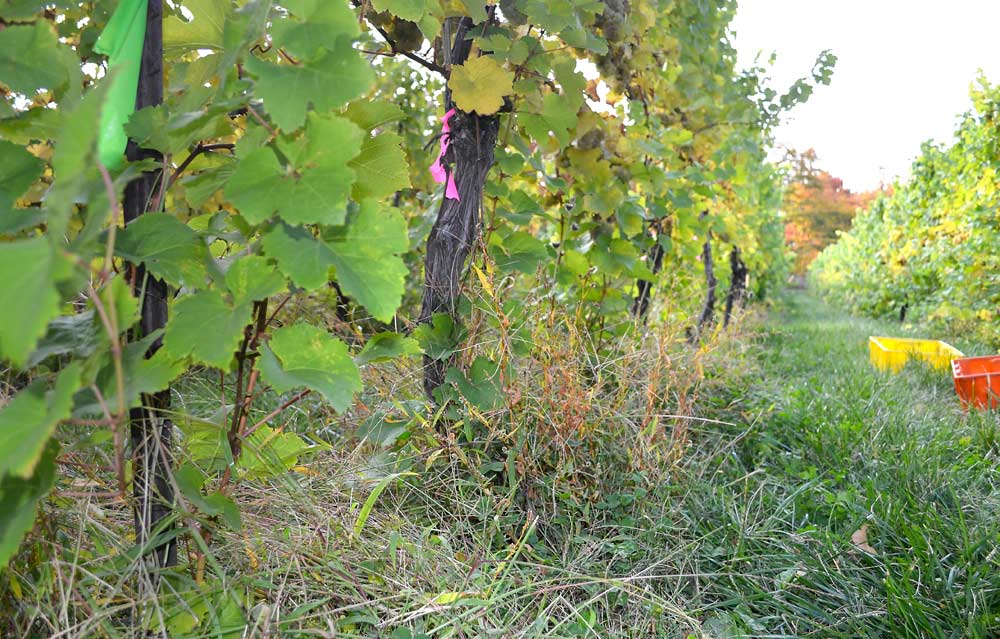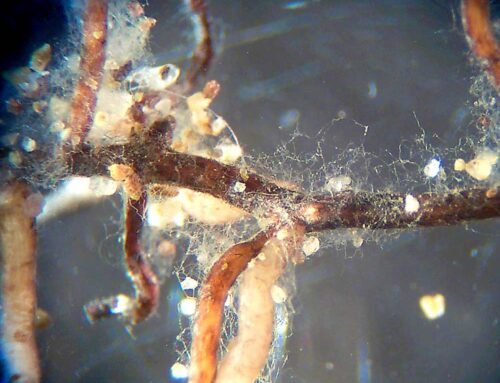
One way for growers to try cover crops beneath their vines is simply to stop trying to maintain bare ground and allow the weeds or “native vegetation” to come up on their own. (Courtesy of Ming-Yi Chou)
Conventional wisdom is to maintain bare ground directly beneath vines in vineyards to prevent weeds from competing with the vines for nutrients and water.
In the cool, humid conditions of the Northeast and much of the Midwest, that conventional wisdom may not be all that smart.
According to a new series of studies, cover crops are not only good for the grapes, but are also better for the environment.

Justine Vanden Heuvel
“There really is no downside to using cover crops,” says Justine Vanden Heuvel, an associate professor at Cornell University’s School of Integrative Plant Science who led the studies.
The studies were published in 2016 in the journals HortTechnology, the American Journal of Enology and Viticulture and HortScience.
The appeal of bare ground has its origins in Concord vineyards.
For this juice grape variety, Northeast growers do everything they can to encourage large vines with high yields, she said.
That includes using herbicides to keep the underlying soil plant-free to reduce competition for water and nutrients.
While that may make sense for Concords, it doesn’t for vinifera, Vanden Heuvel said. “With mature vinifera vineyards, we don’t want that kind of vigor,” she said. “Instead, we want lower quantities of high-quality wine grapes.”
In other words, by maintaining bare ground, growers are often promoting shoot and leaf growth that they don’t want in vinifera. “The bare-ground approach is a historical legacy. That’s all,” she remarked. “There are no research studies that suggest that we really should be doing this in mature vinifera vineyards.”
Vanden Heuvel and her research group conducted a number of experiments over the past four years to test the effect of different cover crops on grapes previously grown with bare ground under the vines.
Specifically, they evaluated buckwheat, annual ryegrass, white clover and “native vegetation.”
She described the latter as a collection of plants that came up on their own once the bare-ground herbicides or cultivation practices were stopped.
As the results came in, the benefits of cover crops were clear. One, the vines and grape production did just fine in the mature plots with cover crops.
In fact, the cover crops drew away some nutrients and water from vinifera, which served to reign in vinifera growth, especially among the younger, productive vines. This resulted in more optimal vine balance, she said.
In addition, the analyses also showed that the costs for seeding and maintaining cover crops were lower than the costs associated with applying herbicides and engaging in cultivation practices to maintain bare ground.
Overall, though, the greatest benefits of cover crops came from their broader impact on the environment, Vanden Heuvel said.
An evaluation of leachate (water that has moved through the soil), revealed that the plots with cover crops contained reduced concentrations of pollutants, including nitrogen as well as the neonicotinoid insecticide imidacloprid, as compared to leachate from bare-soil plots.
Soil erosion was also diminished greatly in plots with cover crops compared to those with bare ground.
“There’s a big environmental cost to open soil through soil erosion and leaching into nearby bodies of water, and this demonstrated that cover crops are a good solution,” she said.
To get started with a cover crop in a vineyard, she suggested that growers simply stop trying to maintain bare ground, allow the weeds to come up on their own, and then monitor the growth to make sure no issues arise.
For example, the cover crop shouldn’t grow up into the fruiting zone where they might contribute to shading or disease, but even if they do get too tall, one sweep with a weed whipper can trim the plants back. Another example is extreme drought.
“In that case, you might want to hit the cover crop with herbicide, so it’s not drawing water from your vines, but even with that extra step, it’s still much easier than maintaining bare ground all season long,” she said.
Vinifera growers really have nothing to lose by giving up bare soil in well established vineyards, Vanden Heuvel contends.
“I highly encourage growers to experiment with cover crops: Try a few rows with some of the different cover-crop cultivars, and see what you think, because our multiple studies show that under-vine cover crops can really make a strong contribution to improving soil health and to reducing management costs.”
Funding for this research came from numerous sources, including grants from the New York State Department of Agriculture and Markets, Specialty Crop Block Grant Program; New York State Department of Agriculture & Markets; Toward Sustainability Foundation; Ronni Lacroute Dean’s Discretionary Fund for Enology and Viticulture at Cornell University; the National Institute of Food and Agriculture, U.S. Department of Agriculture; and the Specialty Crop Research Initiative. •
– by Leslie Mertz






Leave A Comment